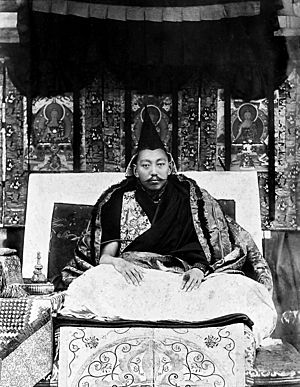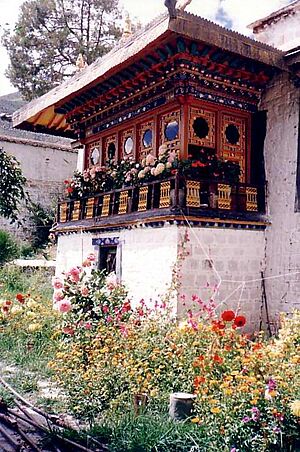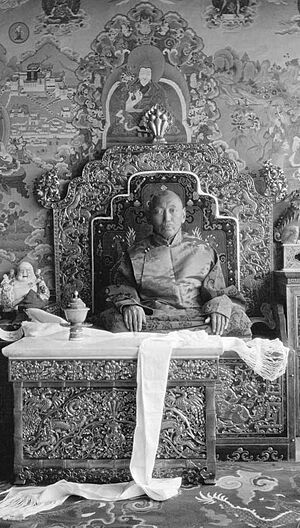13th Dalai Lama facts for kids
Quick facts for kids Thubten Gyatso |
|
|---|---|
| ཐུབ་བསྟན་རྒྱ་མཚོ | |
 |
|
| Religion | Tibetan Buddhism |
| Known for | 13th Dalai Lama |
| Personal | |
| Nationality | Tibetan |
| Home town | Lhasa |
| Born | 12 February 1876 Thakpo Langdun, Ü-Tsang, Tibet |
| Died | 17 December 1933 (aged 57) Lhasa, Tibet |
| Resting place | Potala Palace |
| Parents |
|
| Senior posting | |
| Title | The 13th Dalai Lama |
| Period in office | 31 July 1879 – 17 December 1933 |
| Predecessor | Trinley Gyatso |
| Successor | Tenzin Gyatso |
| Rank | Dalai Lama |
| Religious career | |
| Teacher | Phurchok Ngawang Jampa Rinpoche |
| Reincarnation | Trinley Gyatso |
| Ordination | 1895 |
Thubten Gyatso (born February 12, 1876 – died December 17, 1933) was the 13th Dalai Lama of Tibet. The Dalai Lamas are important spiritual leaders in Tibetan Buddhism. They are believed to be the rebirths of Avalokiteshvara, the Buddha of compassion.
In 1878, when he was just two years old, Thubten Gyatso was recognized as the new Dalai Lama. He was taken to Lhasa, the capital of Tibet. There, he received his first vows from the Panchen Lama, another high spiritual leader. He was given the long name "Ngawang Lobsang Thupten Gyatso Jigdral Chokley Namgyal."
In 1879, he was officially placed on the throne at the Potala Palace. This is a famous and beautiful palace in Lhasa. However, he did not take full political power until 1895, when he was older and ready to lead.
Thubten Gyatso was known as a smart leader who wanted to make things better. He was also a good politician. He worked to improve the rules for monks and increased the number of government officials who were not monks. This helped balance power in Tibet.
Contents
Early Life of the 13th Dalai Lama
The 13th Dalai Lama was born in June 1876. His birthplace was a village called Thakpo Langdun. This village was located southeast of Lhasa. His parents, Kunga Rinchen and Lobsang Dolma, were farmers.
Meeting Agvan Dorzhiev
One important person in the Dalai Lama's life was Agvan Dorzhiev. He was a monk from Mongolia who was also a Russian citizen. Dorzhiev came to Tibet in 1873 to study at Drepung monastery near Lhasa. This was the largest monastery in Tibet.
Dorzhiev became a very learned scholar. He later became a teacher and friend to the young Dalai Lama. The Dalai Lama trusted him and sent him as a special messenger to Russia and other countries.
Tibet's Challenges and the Dalai Lama's Travels
Tibet faced many challenges during Thubten Gyatso's time. Other powerful countries, like Britain and China, were interested in Tibet.
British Influence in Tibet
In 1904, British forces entered Lhasa. This event is known as the British expedition to Tibet. Because of this, the Dalai Lama decided to leave Tibet for a while.
He traveled a very long distance to Mongolia. This journey took four months. While in Mongolia, he met the spiritual leader of Outer Mongolia, the 8th Bogd Gegeen Jebtsundamba Khutuktu.
After the Dalai Lama left, the Chinese government said he was no longer the leader. They also claimed control over Tibet. A treaty was signed between Britain and Tibet in 1904. This treaty was later confirmed in a 1906 agreement between Britain and China.
Dalai Lama's Diplomatic Efforts
The Dalai Lama continued his travels. He stayed at the Kumbum Monastery and then went to Wutai Shan in China. This was a very important Buddhist mountain.
While there, he met many important people from different countries. These included officials from America, Russia, Germany, and Britain. The Dalai Lama was trying to make friends with other nations. He hoped this would help Tibet stay free from Chinese rule.
In 1908, he met with the Chinese Emperor and Empress. The Emperor tried to show that Tibet was under China's control. However, the Dalai Lama refused to bow down to him in a way that showed he was less important. He stayed in Beijing until the end of 1908.
Exile and Return to Tibet
When the Dalai Lama returned to Tibet in 1908, he started to reorganize the government. But in 1910, Chinese troops came to Tibet. The Dalai Lama had to leave again, this time fleeing to India.
In 1911, the Qing dynasty in China was overthrown. By the end of 1912, the last Chinese troops had left Tibet. This allowed the Dalai Lama to return home.
Taking Political Power

In 1895, Thubten Gyatso took full control of Tibet's government. Before this, monasteries and regents (people who ruled in place of a young Dalai Lama) had a lot of power.
His time in exile, from 1904 to 1909 and again from 1910 to 1913, taught him a lot about how countries deal with each other. He was the first Dalai Lama to truly understand how important it was to have good relationships with other nations.
When he returned to Lhasa in January 1913, the new Chinese government apologized. They offered to give him back his old position. But the Dalai Lama said he was not interested in Chinese titles. He declared that he was taking full spiritual and political leadership of Tibet.
He began to manage Tibet's relationships with other countries directly. He talked with leaders from Sikkim, Nepal, and British officials.
Documents from Russia show that the 13th Dalai Lama strongly believed Tibet had never been part of China. In February 1913, he officially declared Tibet's independence from China. He also made the Tibetan flag official. Towards the end of 1912, Tibet also started issuing its own stamps and bank notes.
Modernizing Tibet
Thubten Gyatso worked hard to modernize Tibet.
- In 1913, he built a new medical college called Mentsikang.
- He made new laws to stop officials from being corrupt.
- He created a national tax system that everyone had to follow.
- He also set up a police force.
- The system for punishing criminals was improved. Death sentences were stopped, and other punishments were made less harsh. Prison conditions also got better.
He also started a non-religious education system. He sent four promising students to England to study. He also welcomed visitors from Japan, Britain, and America.
Because of his travels and meetings with people from other countries, the Dalai Lama became interested in world events. He brought new technologies to Tibet, such as electricity, the telephone, and the first cars.
In the last ten years of his life, his assistant, Thubten Kunphela, helped him with many modernization projects. In 1931, a new factory was built in Trapchi. It made money and weapons. This factory was powered by Tibet's first hydroelectric plant. A modern army group was also created that year.
Prophecies and Death
The 13th Dalai Lama made a prediction before he died. He warned that Tibet might face difficult times. He said that if Tibetans did not protect their land, their spiritual leaders and traditions could disappear. He also warned that their political system could vanish, and people might suffer.
Thubten Gyatso passed away on December 17, 1933.
See also
 In Spanish: Thubten Gyatso para niños
In Spanish: Thubten Gyatso para niños



